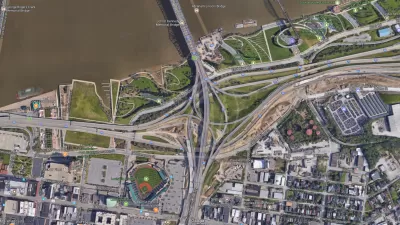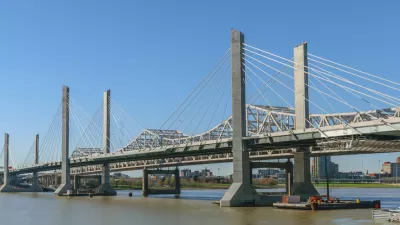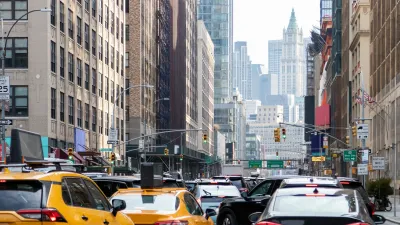Many in the urbanism community were shocked to see the scale of the recently completed "Spaghetti Junction" in Louisville, but the tolling system that will fund the project is just as critical to consider.
Joe Cortright provides context to the news about the recently completed Louisville-Southern Indiana Ohio River Bridges Project, which has quickly gained a level of notoriety thanks to a series of aerial photos of the project's "Spaghetti Junction" released by the Courier-Journal.
According to Cortright, however, "there’s another feature of the new bridge project that we think may be even more egregious than the concrete pasta of the re-built interchange: the new tolling structure that will repay the cost of building the new bridges."
Before explaining the tolling system that will help fund the construction of the bridges, Cortright explains the long planning history that created the Louisville-Southern Indiana Ohio River Bridges Project, but to summarize one main point: the Louisville area now has five bridges crossing the Ohio River. The first problem with the new tolling system is that some of those bridges will be tolled, and some won't.
A larger problem, however, comes from the commuter discount, which creates incentives for driving more frequently, especially toward the end of the month. Then there's the flat rate drivers will pay to cross the river: "since the proposed Louisville tolls don’t vary by time of day, you pay the same price whether you use one of the new bridges at the height of the rush hour, or in the wee hours of the morning when no one else is one the road. This flat-rate tolling structure misses a major opportunity to better manage demand and improve the overall functioning of the transportation system."
Cortright concludes by predicting neither revenue nor congestion will be improved by the tolling system that will go into effect December 30.
FULL STORY: For whom the bridge tolls

Trump Administration Could Effectively End Housing Voucher Program
Federal officials are eyeing major cuts to the Section 8 program that helps millions of low-income households pay rent.

Planetizen Federal Action Tracker
A weekly monitor of how Trump’s orders and actions are impacting planners and planning in America.

Ken Jennings Launches Transit Web Series
The Jeopardy champ wants you to ride public transit.

Washington Legislature Passes Rent Increase Cap
A bill that caps rent increases at 7 percent plus inflation is headed to the governor’s desk.

From Planning to Action: How LA County Is Rethinking Climate Resilience
Chief Sustainability Officer Rita Kampalath outlines the County’s shift from planning to implementation in its climate resilience efforts, emphasizing cross-departmental coordination, updated recovery strategies, and the need for flexible funding.

New Mexico Aging Department Commits to Helping Seniors Age ‘In Place’ and ‘Autonomously’ in New Draft Plan
As New Mexico’s population of seniors continues to grow, the state’s aging department is proposing expanded initiatives to help seniors maintain their autonomy while also supporting family caregivers.
Urban Design for Planners 1: Software Tools
This six-course series explores essential urban design concepts using open source software and equips planners with the tools they need to participate fully in the urban design process.
Planning for Universal Design
Learn the tools for implementing Universal Design in planning regulations.
Heyer Gruel & Associates PA
Ada County Highway District
Institute for Housing and Urban Development Studies (IHS)
City of Grandview
Harvard GSD Executive Education
Toledo-Lucas County Plan Commissions
Salt Lake City
NYU Wagner Graduate School of Public Service





























